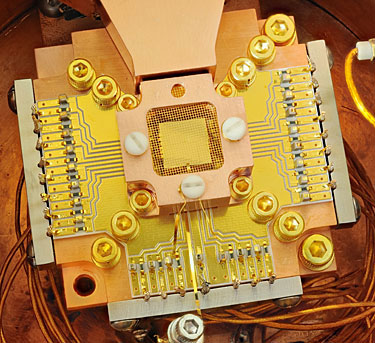| Mar 02, 2011 |
'Quantum tuning forks' demonstrate directly coupling of vibrating ions
|
|
(Nanowerk News) Physicists at the National Institute of Standards and Technology (NIST) have for the first time coaxed two atoms in separate locations to take turns jiggling back and forth while swapping the smallest measurable units of energy. The technique directly links the motions of two physically separated atoms and might simplify information processing in future quantum computers and simulations.
|
 |
| NIST physicists used this apparatus to coax two beryllium ions (electrically charged atoms) into swapping the smallest measurable units of energy back and forth, a technique that may simplify information processing in a quantum computer. The ions are trapped about 40 micrometers apart above the square gold chip in the center. The chip is surrounded by a copper enclosure and gold wire mesh to prevent buildup of static charge. (Credit: Y. Colombe/NIST)
|
|
Described in a recent Nature paper ("Coupled quantized mechanical oscillators"), the NIST experiments enticed two beryllium ions to take turns vibrating in an electromagnetic trap, exchanging units of energy, or quanta, that are a hallmark of quantum mechanics. As little as one quantum was traded back and forth in these exchanges, signifying that the ions are "coupled" or linked together. These ions also behave like objects in the larger, everyday world in that they are "harmonic oscillators" similar to pendulums and tuning forks, making repetitive, back-and-forth motions.
|
|
"First one ion is jiggling a little and the other is not moving at all; then the jiggling motion switches to the other ion. The smallest amount of energy you could possibly see is moving between the ions," explains first author Kenton Brown, a NIST post-doctoral researcher. "We can also tune the coupling, which affects how fast they exchange energy and to what degree. We can turn the interaction on and off."
|
|
The new experiments are similar to the same NIST research group's 2009 demonstration of entanglement—a quantum phenomenon linking properties of separated particles—in a mechanical system of two separated pairs of vibrating ions (see the June 3, 2009, announcement "NIST Physicists Demonstrate Quantum Entanglement in Mechanical System"). However, the new experiments coupled the oscillators' motions more directly than before and, therefore, may simplify information processing. In this case, the researchers observed quantum behavior but did not verify entanglement.
|
|
The new technique could be useful in a future quantum computer, which would use quantum systems such as ions to solve problems that are intractable today. Direct coupling of ions in separate locations could simplify logic operations and help correct processing errors. The technique is also a feature of proposals for quantum simulations, which may help explain the mechanisms of complex quantum systems such as high-temperature superconductors.
|
|
In addition, the demonstration also suggests that similar interactions could be used to connect different types of quantum systems, such as a trapped ion and a particle of light (photon), to transfer information in a future quantum network. For example, a trapped ion could act as a "quantum transformer" between a superconducting quantum bit (qubit) and a qubit made of photons.
|
|
For more details, read the NIST Feb. 23, 2011, news story, "Quantum Hot Potato: NIST Researchers Entice Two Atoms to Swap Smallest Energy Units". This NIST research was supported in part by the Intelligence Advanced Research Projects Activity, Defense Advanced Research Projects Agency and Office of Naval Research.
|

